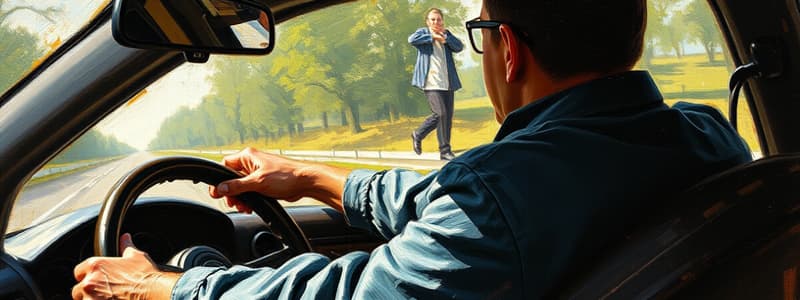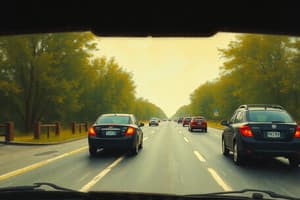Podcast
Questions and Answers
Turnabout is a maneuver for turning the vehicle around to go the opposite way.
Turnabout is a maneuver for turning the vehicle around to go the opposite way.
True (A)
Understeering is not turning the steering wheel enough.
Understeering is not turning the steering wheel enough.
True (A)
Angle parking is when you park at a right angle to the curb.
Angle parking is when you park at a right angle to the curb.
False (B)
Pulling the steering wheel down with one hand while the other hand crosses over is called hand-over-hand steering.
Pulling the steering wheel down with one hand while the other hand crosses over is called hand-over-hand steering.
Angle parking is used to park...
Angle parking is used to park...
Hand-over-hand steering involves...
Hand-over-hand steering involves...
When parking uphill with no curb, your vehicle's front wheels should...
When parking uphill with no curb, your vehicle's front wheels should...
How much space should be allotted to park your vehicle parallel to the curb?
How much space should be allotted to park your vehicle parallel to the curb?
To back to the left, you...
To back to the left, you...
A beginning driver may tend to oversteer. This means the driver...
A beginning driver may tend to oversteer. This means the driver...
Regardless of the hill you park on, you should...
Regardless of the hill you park on, you should...
Use perpendicular parking to park...
Use perpendicular parking to park...
Always prepare to straighten your vehicle after a turn by...
Always prepare to straighten your vehicle after a turn by...
To keep your vehicle from rolling into the street when parking downhill on the right with a curb, set the parking brake after...
To keep your vehicle from rolling into the street when parking downhill on the right with a curb, set the parking brake after...
A disadvantage of pulling into a driveway on the left side to turnabout is that you must...
A disadvantage of pulling into a driveway on the left side to turnabout is that you must...
What allows you to back a standard drive vehicle at a controlled speed?
What allows you to back a standard drive vehicle at a controlled speed?
When do you turn your wheels sharply left before backing slowly in a parallel parking maneuver?
When do you turn your wheels sharply left before backing slowly in a parallel parking maneuver?
To make sharp turns while backing...
To make sharp turns while backing...
To plan for a turn, you should...
To plan for a turn, you should...
The three-point turnabout...
The three-point turnabout...
To steer straight forward, look...
To steer straight forward, look...
Why do you avoid parking in a space next to a badly parked vehicle?
Why do you avoid parking in a space next to a badly parked vehicle?
Why should you place your right hand near the top of the steering wheel when beginning a left turn?
Why should you place your right hand near the top of the steering wheel when beginning a left turn?
Which lane should you be in to begin a left turn from a two-way street?
Which lane should you be in to begin a left turn from a two-way street?
When backing to the right, after checking all around the vehicle, look to the...
When backing to the right, after checking all around the vehicle, look to the...
Making proper turns depends on...
Making proper turns depends on...
Just before beginning any lane-change maneuver...
Just before beginning any lane-change maneuver...
A turnabout maneuver is risky because...
A turnabout maneuver is risky because...
For a right turn, start turning the steering wheel when...
For a right turn, start turning the steering wheel when...
You need to downshift to slow for a turn. Why should you complete the downshift before the turn?
You need to downshift to slow for a turn. Why should you complete the downshift before the turn?
Backing into a driveway or an alley on the right side is the safest turnabout maneuver.
Backing into a driveway or an alley on the right side is the safest turnabout maneuver.
Prepare to make a turnabout safely by selecting...
Prepare to make a turnabout safely by selecting...
A standard reference point might be...
A standard reference point might be...
As you back your vehicle straight, your right arm should be over the back of the seat so you can...
As you back your vehicle straight, your right arm should be over the back of the seat so you can...
When leaving a parallel parking space, you...
When leaving a parallel parking space, you...
Before turning right, your last check for traffic should be...
Before turning right, your last check for traffic should be...
When backing to the left, the front wheels move...
When backing to the left, the front wheels move...
After completing a parallel parking maneuver, your vehicle should...
After completing a parallel parking maneuver, your vehicle should...
The hand signal to indicate slow or stop is...
The hand signal to indicate slow or stop is...
The correct hand signal for a left turn is...
The correct hand signal for a left turn is...
Flashcards are hidden until you start studying
Study Notes
Vehicle Maneuvers and Parking Techniques
- Turnabout: A maneuver to rotate the vehicle to head in the opposite direction.
- Understeering: Occurs when the driver fails to turn the steering wheel enough.
- Angle Parking: Involves parking diagonally to the curb, not at a right angle.
- Hand-over-Hand Steering: Technique used where one hand pulls the steering wheel down while the opposite hand crosses over to gain more control.
- Parking Space Requirement: To parallel park, allow for a space that is 5-6 feet longer than your vehicle.
Parking Guidelines
- Uphill Parking without a Curb: When parked on a hill without a curb, turn front wheels to the right.
- Downhill Parking: Set the parking brake after turning the steering wheel sharply to the right.
- Perpendicular Parking: Involves parking at a right angle to the curb.
- Parallel Parking Maneuver: Look through rear and side windows in the direction of the desired backing movement.
Steering and Turning Techniques
- Straightening After a Turn: Use hand-over-hand steering to prepare to re-align the vehicle.
- Marking for Turns: Begin a left turn when the front wheels are even with the curb or corner bend.
- Lane Positioning: For left turns from a two-way street, position the vehicle in the lane closest to the center line.
- Turning Signals: Indicate a left turn with your left arm and hand extending straight out, and signal a stop with your left arm pointing downward.
Safety Protocols
- Visibility Checks: Ensure you check for obstructions before executing lane changes.
- Backing Safety: When backing, always look over your right shoulder and check surroundings.
- Avoiding Badly Parked Vehicles: Steer clear of spaces next to poorly parked cars to prevent potential damage.
- Set the Parking Brake: Regardless of the hill's slope, always engage the parking brake when parked.
Additional Driving Tips
- Clutch Control: When driving a standard vehicle, maintaining the clutch at a friction point helps in controlling speed.
- Three-Point Turnabout: This maneuver is considered risky and should be used sparingly due to potential traffic conflicts.
- Parallel Parking Completion: After parking, ensure the vehicle is centered within the designated space.
- Yielding While Leaving a Parallel Park: Always yield to incoming traffic when exiting a parking space.
Hand Signals and References
- Standard Reference Point: Use visual markers like a hood ornament to help gauge distance and positioning.
- Hand Signals: For slowing or stopping, extend your left arm and hand downward to indicate your intention to other drivers.
Studying That Suits You
Use AI to generate personalized quizzes and flashcards to suit your learning preferences.




